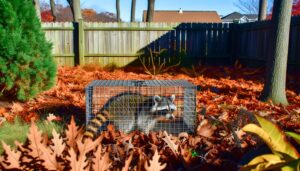3 Steps to Take a Trapped Raccoon Far
Relocating a trapped raccoon requires careful attention to legal and ecological guidelines. The animal should be transported at least 5-10 miles away to prevent returning.
Guarantee the new site provides sufficient food, water, and shelter. Compliance with local wildlife regulations and humane treatment is essential.
Proper personal protective equipment is necessary to mitigate zoonotic disease risks. Approved relocation sites support the raccoon's survival and minimize ecosystem disruption.
Understanding these factors not only guarantees successful relocation but also preserves ecological balance and public safety. For a more thorough understanding, consider additional sources on wildlife management practices.

Key Takeaways
- Relocate raccoons 5-10 miles away to prevent their return.
- Ensure the relocation site has adequate food and water sources.
- Follow local wildlife regulations for distance and humane treatment.
- Choose a release area with minimal human activity and sufficient shelter.
- Comply with transport guidelines to prevent escape or harm during relocation.
Understanding Raccoon Behavior
Understanding raccoon behavior necessitates an examination of their nocturnal activity patterns, foraging strategies, and social structures. These elements are pivotal for developing effective wildlife management practices.
Raccoons (Procyon lotor) exhibit crepuscular and nocturnal tendencies, primarily active during twilight and night hours. Their foraging involves omnivorous diets, utilizing tactile sensitivity in their forepaws to locate diverse food sources, from invertebrates to human refuse.
Socially, raccoons display flexible dynamics, often solitary but occasionally forming loose, transient groups, particularly during resource abundance. Seasonal behaviors, including denning in colder months, also influence their activity.
Legal Considerations
When managing a trapped raccoon, compliance with local wildlife regulations is essential to guarantee adherence to conservation laws.
Moreover, obtaining the necessary permits and licenses is vital for lawful capture and relocation activities.
Additionally, distance transport laws must be taken into account to avoid wildlife stress and potential ecological disruptions.
Local Wildlife Regulations
Understanding local wildlife regulations is vital to guarantee legal compliance and humane treatment when dealing with a trapped raccoon. Regulations vary by jurisdiction, but typically include stipulations on trapping methods, handling, and relocation.
Authorities may designate specific areas where raccoons can be released, often requiring relocation within a set distance to prevent the spread of disease and maintain ecological balance. Non-compliance can result in legal penalties and unintended ecological consequences.
Additionally, regulations prioritize the humane treatment of raccoons, mandating the use of non-lethal traps and proper care during handling. It is important to consult local wildlife agencies to understand specific requirements, ensuring that all actions taken are both ethical and lawful.
Permit and Licensing
Compliance with local wildlife regulations often requires obtaining the appropriate permits and licenses to legally trap and relocate raccoons. This guarantees alignment with conservation principles and mitigates risks to both the animal and the ecosystem.
When considering permits and licenses, it is crucial to account for several critical factors:
- Regulatory Jurisdiction: Different regions may have specific requirements.
- Permit Types: Distinct permits for trapping, relocation, and handling may be necessary.
- Wildlife Health Protocols: Health assessments to prevent disease transmission.
- Seasonal Restrictions: Certain times of the year may have additional regulations.
- Record-Keeping: Documentation of trapping and relocation activities for compliance.
Understanding and adhering to these elements guarantees ethical and lawful wildlife management practices.
Distance Transport Laws
Adhering to distance transport laws is crucial for guaranteeing the humane and legal relocation of trapped raccoons. Regulations vary by jurisdiction but generally stipulate maximum allowable distances to prevent ecological disruption and disease transmission.
For instance, many states mandate relocation within a specific range, typically 5-10 miles, to minimize stress on the animal and guarantee it can adapt to the new habitat. Compliance with these laws requires understanding local wildlife statutes and obtaining necessary permits. Failure to comply can result in significant legal repercussions, including fines and penalties.
Additionally, relocation efforts should incorporate best practices in wildlife management, ensuring ethical treatment and alignment with conservation goals. Always consult with local wildlife authorities before proceeding with relocation activities.
Local Wildlife Regulations
Local wildlife regulations stipulate specific protocols for the humane capture and relocation of raccoons to safeguard both public safety and animal welfare. These regulations are designed to align with ecological balance and legal frameworks.
Key aspects include:
- Permit Requirements: Obtaining necessary permits from local wildlife authorities before trapping and relocating raccoons.
- Approved Relocation Sites: Securing that the release site is an approved habitat that supports raccoon survival and does not disrupt local ecosystems.
- Humane Trapping Methods: Using traps that minimize stress and injury to the animal.
- Transport Guidelines: Following guidelines on containment and transportation to prevent escape or harm.
- Reporting: Providing detailed reports of capture and relocation activities to wildlife authorities for monitoring and record-keeping.
These measures guarantee ethical and effective wildlife management practices.
Health and Safety Concerns
Addressing health and safety concerns is paramount when dealing with trapped raccoons due to the high risk of zoonotic disease transmission, including rabies and leptospirosis. Proper handling protocols require the use of personal protective equipment (PPE) such as gloves and face shields to mitigate these risks.
Adherence to these guidelines guarantees both human safety and humane treatment of the animal.
Disease Transmission Risks
Raccoons, as carriers of zoonotic pathogens, pose significant disease transmission risks to humans and other animals through direct contact or environmental contamination. It is important to understand the potential health hazards associated with these animals to implement effective preventive measures.
Key diseases transmitted by raccoons include:
- Rabies: A fatal viral infection affecting the central nervous system.
- Leptospirosis: A bacterial disease causing liver and kidney damage.
- Baylisascaris procyonis: A parasitic roundworm leading to severe neurological damage.
- Salmonellosis: An infection caused by Salmonella bacteria, resulting in gastrointestinal distress.
- Giardiasis: A parasitic disease causing diarrhea and abdominal discomfort.
Awareness and proper handling protocols are essential to mitigate these risks and promote public health safety.
Handling Protective Gear
Utilizing appropriate protective gear is crucial to minimizing health and safety risks when handling raccoons or their contaminated environments. Personal protective equipment (PPE) such as heavy-duty gloves, long sleeves, and face shields are essential to prevent direct contact with zoonotic pathogens.
According to the Centers for Disease Control and Prevention (CDC), raccoons can carry diseases such as rabies, leptospirosis, and raccoon roundworm (Baylisascaris procyonis). The use of a respirator mask is recommended to mitigate inhalation of airborne contaminants, including droppings and urine.
Proper decontamination procedures should follow any interaction, involving the use of disinfectants effective against viral and bacterial agents. Adhering to these protocols significantly reduces the risk of transmission and ensures safer handling practices.
Humane Trapping Methods
Implementing humane trapping methods involves selecting traps that minimize stress and injury to the raccoon while guaranteeing effective capture. Utilizing live-capture cage traps made of durable materials with smooth, rounded edges is essential. These traps should be appropriately sized to allow the raccoon to move without causing harm.
- Trap Design: Opt for wire mesh traps with a solid base to prevent paw injuries.
- Bait Selection: Use food items like marshmallows or canned fish to attract raccoons without causing distress.
- Trap Placement: Position traps in shaded, quiet areas to reduce environmental stress.
- Monitoring: Check traps frequently (at least twice daily) to minimize the raccoon's time in confinement.
- Release Mechanism: Guarantee the trap has an easy-to-use release mechanism to facilitate quick and safe relocation.
Choosing a Relocation Spot
When selecting an appropriate relocation site for a trapped raccoon, it is vital to guarantee proximity to dependable water sources, which are essential for hydration and foraging.
The area must also provide sufficient food availability, such as varied vegetation and small animals, to support the raccoon's dietary needs.
Additionally, the chosen habitat should offer secure shelter options, such as thick foliage or natural cavities, to protect the raccoon from predators and environmental stressors.
Proximity to Water Sources
Choosing a suitable relocation spot for a trapped raccoon requires careful consideration of the proximity to natural water sources to ensure the animal's survival and well-being. Access to water is essential as it supports hydration, thermoregulation, and provides a habitat for various prey species. Ensuring raccoons are relocated near reliable water sources can greatly improve their adaptation to new environments.
- Hydration: Immediate access to fresh water is vital for raccoon survival.
- Thermoregulation: Water bodies help in maintaining body temperature during extreme weather conditions.
- Habitat: Water sources support ecosystems that raccoons rely on for shelter.
- Prey Availability: Aquatic environments harbor prey like fish and amphibians.
- Vegetation: Proximity to water promotes plant growth, offering foraging opportunities.
Careful site selection promotes ecological balance and animal welfare.
Adequate Food Availability
In addition to securing proximity to water sources, identifying relocation sites with abundant and diverse food availability is crucial for the sustenance and health of raccoons.
Raccoons are omnivorous and their diet includes fruits, nuts, insects, small mammals, and aquatic organisms. An ideal relocation spot should offer a variety of these food sources to support a balanced diet.
Research indicates that areas rich in vegetation and near bodies of water are optimal, as they typically harbor a higher density of food resources. Evaluating the local ecosystem's carrying capacity is essential to prevent resource depletion and promote long-term viability.
Ensuring sufficient food availability mitigates stress and supports successful adaptation to the new environment.
Safe Shelter Options
Identifying safe shelter options is crucial for the successful relocation of raccoons, as it directly impacts their survival and adjustment. Selecting an appropriate relocation spot requires a thorough understanding of the raccoon's ecological needs and habitat preferences. Essential considerations include:
- Proximity to water sources: Guarantees availability of hydration and supports diverse prey populations.
- Diverse vegetation: Offers cover from predators and harsh weather while sustaining food sources.
- Low human activity: Reduces human-wildlife conflicts and enhances chances of successful adaptation.
- Existing raccoon population: Indicates the habitat's suitability but necessitates careful assessment to avoid overpopulation.
- Denning sites: Availability of natural dens like hollow trees or rock crevices provides immediate shelter.
These factors collectively improve the likelihood of a smooth shift and long-term survival for relocated raccoons.
Distance Recommendations
Maintaining a minimum distance of 30 feet from a trapped raccoon is important to minimize stress for the animal and guarantee human safety. This buffer helps prevent the transmission of zoonotic diseases such as rabies.
Scientific studies recommend relocating raccoons at least 5-10 miles away from the capture site to avoid return. This distance ensures that the raccoon does not disrupt local populations or engage in homing behavior.
It is vital to release raccoons in environments with adequate food sources and shelter to support their survival. Regulatory guidelines often mandate specific relocation distances, and compliance with local wildlife management policies is necessary to ensure ethical and lawful handling of these animals.
Impact on Ecosystems
Relocating raccoons can notably alter local ecosystems by introducing new competitors, predators, or potential disease vectors. Such disruptions can have cascading effects on biodiversity and ecological balance.
For instance, relocated raccoons may compete with native species for food and habitat, leading to resource depletion and population declines. Additionally, raccoons are known carriers of rabies and other zoonotic diseases, which could spread to native wildlife and even humans.
- Competition: Increased competition for limited resources can affect the survival of native species.
- Predation: Raccoons may prey on local fauna, disrupting established food webs.
- Disease transmission: Introducing new pathogens can jeopardize the health of local wildlife.
- Behavioral changes: Native species may alter their behavior in response to new stressors.
- Habitat alteration: Raccoons can cause significant changes to habitat structure and quality.
Potential Risks of Relocation
The relocation of raccoons poses significant ecological and public health risks due to their potential to disrupt native ecosystems and transmit zoonotic diseases. Introducing raccoons into non-native areas can lead to competition with indigenous species, thereby threatening local biodiversity. Additionally, raccoons are known carriers of pathogens such as rabies, leptospirosis, and raccoon roundworm, which can be transmitted to humans and other animals. These risks necessitate careful consideration and evidence-based strategies to manage raccoon populations effectively.
| Risk Factor | Description | Impact |
|---|---|---|
| Ecological Disruption | Competition with native species | Loss of biodiversity |
| Disease Transmission | Rabies, leptospirosis, raccoon roundworm | Public health threat |
| Habitat Alteration | Nesting and foraging behaviors | Ecosystem imbalance |
| Human-Wildlife Conflict | Increased encounters with humans | Property damage, safety concerns |
Alternatives to Relocation
Exploring humane and effective methods such as exclusion techniques, habitat modification, and fertility control can mitigate the negative impacts of raccoon presence without the need for relocation.
Exclusion techniques involve sealing entry points to prevent raccoon access to structures. Habitat modification includes removing attractants like food sources and shelter options. Fertility control can reduce raccoon population growth through immunocontraceptives. These strategies are supported by scientific evidence and offer sustainable solutions.
- Exclusion techniques: Sealing gaps, installing raccoon-proof barriers.
- Habitat modification: Removing food sources, securing trash cans.
- Fertility control: Use of immunocontraceptives to limit population growth.
- Behavioral deterrents: Utilizing motion-activated lights or sprinklers.
- Public education: Informing communities about raccoon-proofing properties.
These methods provide a balanced approach to managing raccoon populations.
Post-Relocation Monitoring
Once raccoons are relocated, implementing rigorous post-relocation monitoring is crucial to assess the success of the intervention and the well-being of the animals. Monitoring involves tracking the animals' movements, health status, and adaptation to the new habitat. Utilization of GPS collars and remote cameras enables precise data collection.
| Monitoring Parameter | Purpose |
|---|---|
| Movement Tracking | Verifies raccoons remain within the designated area. |
| Health Assessments | Evaluates physical condition post-relocation. |
| Habitat Utilization | Observes interaction with the new environment. |
| Mortality Rates | Assesses survival rates and causes of death. |
| Behavioral Changes | Detects stress or unusual behavior. |
These parameters offer invaluable insights, guiding future relocation efforts and improving outcomes for relocated raccoons.
Seeking Professional Help
Engaging licensed wildlife specialists is essential to guarantee the proper handling, relocation, and monitoring of raccoons, thereby maximizing the success of conservation interventions. These experts possess the necessary knowledge and experience to manage raccoon welfare effectively, promoting minimal stress and risk to both the animals and human populations. Professional involvement promotes adherence to legal requirements and best practices in wildlife management.
- Humane capture techniques: Specialists utilize methods that minimize harm and stress to raccoons.
- Regulatory compliance: Ensures all activities align with local and federal wildlife regulations.
- Expert assessment: Accurate evaluation of raccoon health and suitability for relocation.
- Post-relocation monitoring: Continuous observation to promote the raccoon's adaptation and well-being.
- Ecological impact assessment: Evaluates the effects of relocation on the new habitat and existing wildlife.
Conclusion
In the labyrinth of human-wildlife interaction, the journey of the raccoon epitomizes the delicate balance of ecological stewardship. Legal mandates, health protocols, and humane methodologies intertwine to form an intricate tapestry, guiding the ethical treatment of these nocturnal wanderers.
Relocation, albeit fraught with potential pitfalls, must be meticulously navigated with scientific precision. Ultimately, like guardians of a delicate domain, one must weigh the scales of intervention, ensuring the harmonious coexistence of humans and the natural order.






